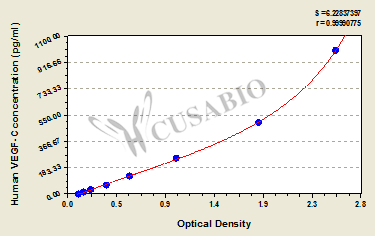The human VEGFC ELISA Kit is engineered for accurate measurement of human VEGFC levels from samples including serum, plasma, or tissue homogenates. It uses the Sandwich-ELISA mechanism in combination with the enzyme-substrate chromogenic reaction to measure the VEGFC content in the sample. The color intensity is positively correlated with VEGFC content in the sample. The VEGFC concentration can be calculated according to the standard curve. This kit is tested with high sensitivity, strong specificity, good linearity, high precision and recovery, as well as lot-to-lot consistency.
The VEGFC signaling through VEGFR-3 is essential for leukemic cell proliferation, survival, and resistance to chemotherapy. VEGFC is considered as a tumor lymphangiogenic factor based on the effects of activated VEGF-R3 on lymphatic endothelial cells. In several types of solid tumors, activation of the VEGFC/VEGFR-3 axis in increases cancer cell mobility and invasion capabilities, facilitating cancer cell metastasis. VEGFC expression has been associated with advanced metastasis in colorectal cancer and plays a role in lymphangiogenesis and/or metastasis to lymph nodes in multiple types of cancer, including colorectal and breast cancer.






